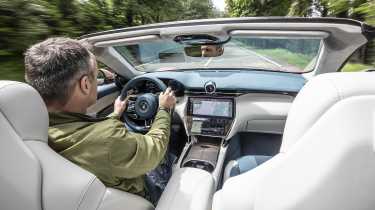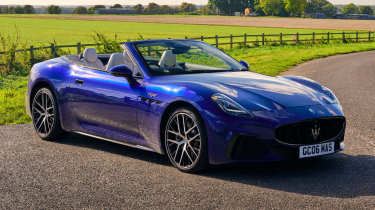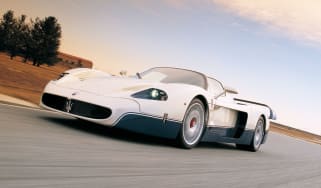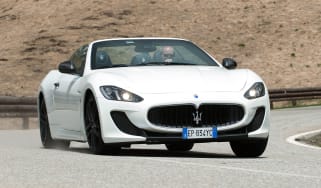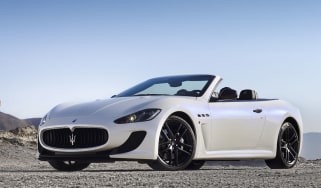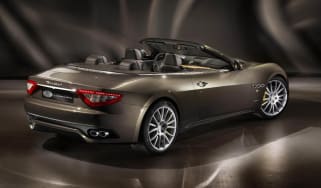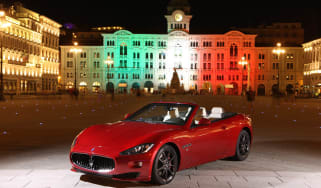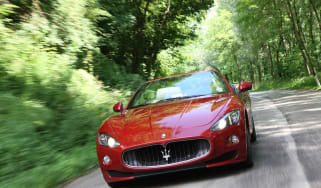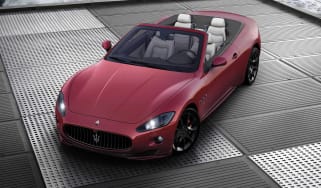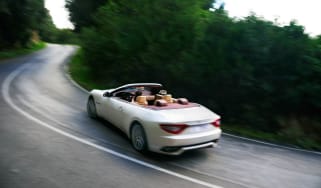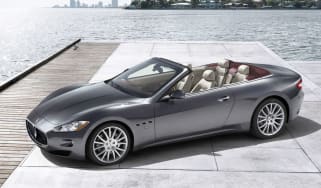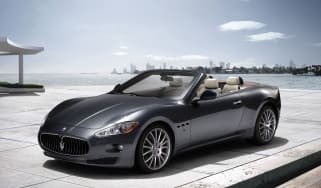Maserati GranCabrio Trofeo 2024 review – a worthy Aston Martin DB12 Volante alternative?
While not as sharp as some of its rivals, the drop-top GranCabrio strikes a pleasing balance, retaining the outstanding GT abilities of the hardtop
We’ve been fans of the Maserati GranTurismo since we first drove it, so much so, it received an invite to eCoty 2023, where despite finishing in the final spot it still impressed us with its rather unique blend of pace, grace and practicality. When first driving the GranCabrio in Italy, we found a car that, like the coupe, found a desirable compromise between sports car and grand tourer. It faces perhaps its toughest test on this side of the Channel however, on Britain’s rutted asphalt. Does the GranCabrio continue to charm on evo’s home turf and present enough of a case to choose it over the Aston Martin DB12 Volante?
Pop the bonnet – or the ‘cofango’ as Maserati refer to it, a sprawling panel that combines the bonnet with the front wings – and it’s immediately apparent that the long nose is by no means necessary to contain the engine. The Nettuno twin-turbocharged V6 is entirely behind the front axle line, contributing to a 51:49 weight distribution (50:50 in the Folgore). The 3-litre motor features Maserati’s twin combustion tech (MTC) as seen first in the MC20, but unlike the supercar is in wet sump form here. It produces 542bhp and 479lb ft of torque.
More reviews
> Maserati GranTurismo Trofeo 2024 review
The GranCabrio was developed alongside the coupe from the beginning, the platform designed to offer the flexibility to support all variants while sharing as much in common as possible, including passing down the same production line.
The chassis is of a hybrid construction that consists of 65 per cent aluminium, but with additional bracing underneath to claw back rigidity lost with the application of the tin opener on the roof. Maserati’s engineers describe the cabrio as having comparable rigidity to the structure of the coupe, although there is a 100kg weight penalty once bracing and roof mechanisms have been taken into consideration. Incidentally, that difference narrows to 80kg on the all-electric version as the battery pack mounted underneath the car has a bracing effect all of its own. Then again, the weight penalty overall to go electric is considerable, the Folgore version tipping the scales at a hefty 2340kg.
Down by 100bhp the Trofeo may be on the Aston Martin DB12 Volante’s twin-turbocharged V8 but no one seems to have explained that to the little V6. It remains an effervescent, eager mill, ripping and rasping up through the revs to deliver a whip-crack in the exhaust with every gear shift in Sport or Corsa mode. With the eight-speed ZF ‘box sending power to all four wheels, the GranCabrio Trofeo launches to 62mph from rest in just 3.6 seconds, a tenth ahead of the rear-drive Aston; it also trails its top speed by just 6mph (196 versus 202mph).
These fireworks initially juxtapose in the simple, elegant, if vast GranCabrio. Far from revolutionary compared to its predecessor it may be, but you can’t deny it has quite some presence, particularly with the roof stowed. It is extravagantly proportioned, but pleasingly free from visual clutter, and as you walk up to it, the sheer impressive scale of the car becomes readily apparent. That roof takes just 14 seconds to lower should conditions allow, and 16 to raise it, with both possible at up to 31mph.
It’s a modish but slightly overwrought exercise in place of a normal button that would do perfectly well, but then the Maser’s interior is very touchscreen heavy, which brings the usual frustrations. Nevertheless, this one seemed to react a bit faster than the last one we tried and is surprisingly intuitive and easy to gell with. Over just a couple of days with the GranCabrio, the day-to-day controls and processes quickly became second nature.
The interior generally is much like the coupe’s, with an excellent driving position, a general air of quality and an airy feel compared to Gaydon’s more cramped soft-top GT. It’s just a shame it slightly lacks the wow factor of its (more expensive) rivals, although there’s no doubting it’s a comfortable place to be. It’s more practical too, with a genuine pair of human-sized seats in the back that can be used for more than just extra storage.
Once you calm the crackling V6 down, the GranCabrio is particularly adept at relaxing progress, and wind buffeting with the roof lowered is especially well contained. A neck warmer (hot air blown out through the top of the seat) does away with any nasty drafts in cooler climes. Like the GranTurismo, it uses air suspension and is genuinely pliant in GT mode. The steering is quick but not nervously so, and has an oily accuracy that suits the soft-edged ride; it really does make very few demands on the driver.
Like all air-suspended cars, it can feel a little flat-footed on certain smaller, awkward surfaces at speed, that occasionally catch it out with a wobble, but you’d think nothing of doing many hundreds of miles a day in this car.
Up the ante to Sport and the suspension firms up, as the engine develops a bit more growl. Even if it feels like it’s bracing itself for a brawl, it’s still a pleasingly fluid car to drive quickly, with a natural informative lean to the body as you approach the limit, working pleasingly in the middleground between wallowing and artificial flatness. There's loads of traction to the point that you have to drive the car beyond its area of comfortability to make it break away, but it's not one to collapse into understeer; it never feels obviously four-wheel drive. It’s capable, secure, and satisfying, if not outright thrilling.
Corsa drops the ride height as well as stiffening the suspension further, and this is a little less successful: ultimately the GranCabrio is a big, heavy car – not the type you feel inclined to push overly hard in when raw physics start to come into play. The car makes the inappropriateness of Corsa evident fairly swiftly on furrowed English lanes, pogoing up and down and regularly grazing its chin. Sport works best for the best compromise of engaging yet unfettered progress on most UK roads.
What of the electric Folgore? Well, as someone who’s always seen a charismatic Italian internal combustion engine as a key part of the Maserati recipe, particularly when the cars of the past have often been a bit flaky in other areas, I have to say the idea didn’t exactly thrill me. But in all honesty, it does work well, as long as you’re buying this car principally as comfortable, stylish transport. It’s searingly fast in a straight line, too, and there’s a real novelty factor in being able to hear nature as you pass through it. Then again, without that sense of mechanical interaction the experience left me cold, there’s no hiding the weight when you want to push on a bit, and I’d never take one over the Trofeo. At £185,610, it’s more expensive, too.
Overall, the GranCabrio’s biggest strength is its unique blend of characteristics. In spite of having the heart of a supercar – that engine is a joy to wind up – it’s more GT than a DB12 but more sports car than a Bentley Continental GTC. It’s considerably cheaper than both on price, too. Maserati like to point out they’ve been making cars like this for decades, and it has to be said that with the new GranCabrio, that experience seems to count for plenty.
Price and rivals
The GranCabrio Trofeo will set you back from £169,585 in the UK, a £5995 premium over its GranTurismo sibling – unlike the coupe, there is no entry-level Modena variant available for the drop-top. The all-electric Folgore costs considerably more at £185,610, but rivals are virtually non-existent in 2024, with the 496bhp MG Cyberster GT the closest you’ll get (£59,995).
The £171,965 Mercedes-AMG SL63 is the GranCabrio’s closest match in terms of price and output, with 577bhp coming from its pure-combustion 4-litre twin-turbo V8 for an identical 3.6sec 0-62mph time. The new Bentley Continental GTC Speed is another potential rival, but with a much higher 771bhp output from its hybrid V8 and a lofty £259,500 price tag, it’s not a perfect match. The same can be said for the 671bhp Aston Martin DB12 Volante at £203,000 and Ferrari’s 611bhp Roma Spider which starts at £210,313.


